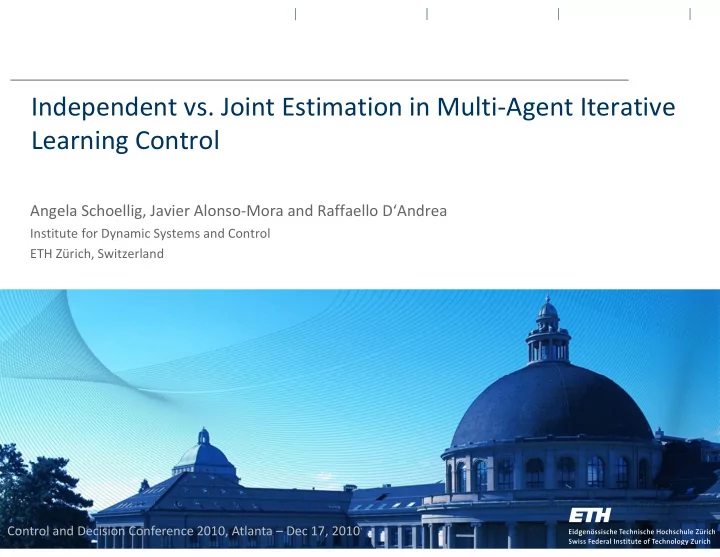

Independent vs. Joint Estimation in Multi ‐ Agent Iterative Learning Control Angela Schoellig, Javier Alonso ‐ Mora and Raffaello D‘Andrea Institute for Dynamic Systems and Control ETH Zürich, Switzerland 1 Control and Decision Conference 2010, Atlanta – Dec 17, 2010
SYSTEMS ARE ABLE TO LEARN Open ‐ loop swing ‐ up of a cart ‐ pendulum system. [Schöllig and D'Andrea, ECC 2009] https://youtu.be/W2gCn6aAwz4?list=PLC12E387419CEAFF2 Angela Schoellig ‐ ETH Zürich 2
CAN SIMILAR SYSTEMS BENEFIT FROM EACH OTHER... …when learning the same task? Blind Juggler Array Flying Machine Arena KIVA Systems Distributed Flight Array Balancing Cube Angela Schoellig ‐ ETH Zürich 3
PROBLEM STATEMENT We consider • A group of similar agents • Performing the same task • Repeatedly • Simultaneous operation Is an individual agent able to learn faster when performing a task simultaneously with a group of similar agents? Angela Schoellig ‐ ETH Zürich 4
SIMILAR AGENTS (1) Same nominal dynamics. Physical model of real ‐ world system Same task. GOAL OF LEARNING: Follow the desired trajectory. Angela Schoellig ‐ ETH Zürich 5
SIMILAR AGENTS (2) Linearize. Small deviations from nominal trajectory. Discretize. Linear, time ‐ varying difference equations. Lifted ‐ system representation. Static mapping representing one execution. With and Angela Schoellig ‐ ETH Zürich 6
SIMILAR BUT NOT IDENTICAL... In the iteration domain. For trial : Agent index Measurement noise Process noise Iteration index For each agent : REPETITIVE DISTURBANCE Same nominal dynamics. Same task. Different repetitive disturbance. Angela Schoellig ‐ ETH Zürich 7
HOW DOES A SINGLE AGENT LEARN? EXECUTE NEW ITERATION (1) Estimate the repetitive disturbance by taking into ESTIMATE account all past measurements. Obtain . CORRECT (2) Correct for by updating the input. “Minimize” . For example, Can the disturbance estimate be improved by taking into account the measurements of the other agents? Angela Schoellig ‐ ETH Zürich 8
FOCUS: ESTIMATION PROBLEM INDEPENDENT ESTIMATION vs. JOINT ESTIMATION Angela Schoellig ‐ ETH Zürich 9
REDUCE MODEL DYNAMICS with neglect deterministic part assume state is measured directly assume independence and same noise characteristics for vector entries MEASUREMENT AND PROCESS NOISE LEARNING PERFORMANCE is measured by the variance of the state estimate. Angela Schoellig ‐ ETH Zürich 10
JOINT ESTIMATION Estimation objective. Kalman equations. Variance of disturbance estimate. PROPOSITION: Covariance of an individual’s disturbnance estimate INDEPENDENT CASE: Angela Schoellig ‐ ETH Zürich 11
COMPARISON COVARIANCE OF STATE ESTIMATE: with RATIO OF COVARIANCE: independent vs. joint estimation (I) PURE PROCESS NOISE (II) PURE MEASUREMENT NOISE Angela Schoellig ‐ ETH Zürich 12
RESULT Performance increase due to joint estimation: THEOREM 1: Pure Process Noise limit case for THEOREM 2: Pure Measurement Noise limit case for Angela Schoellig ‐ ETH Zürich 13
EXAMPLE For 10 agents: 14
JOINT ESTIMATION IS ONLY BENEFICIAL IF... (1) High similarity between agents (2) Process noise negligible (3) Common model error large compared to the noise Angela Schoellig ‐ ETH Zürich 15
Independent vs. Joint Estimation in Multi ‐ Agent Iterative Learning Control Angela Schoellig, Javier Alonso ‐ Mora and Raffaello D‘Andrea Institute for Dynamic Systems and Control ETH Zürich, Switzerland 16 Control and Decision Conference 2010, Atlanta – Dec 17, 2010
Recommend
More recommend